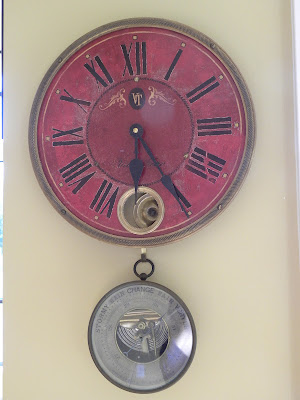 |
| My reliable Timex |
Well, it is that time of the year again when we change our clocks to Daylight Saving Time (DST) or summer time, from Standard Time (ST). In doing this we gain more daylight in the evening but we lose an hour of sleep.
 |
According to Wikipedia:
"Though mentioned by Benjamin Franklin in 1784, the modern idea of daylight saving was first proposed in 1895 by George Vernon Hudson [8] and it was first implemented during the First World War. Many countries have used it at various times since then; details vary by location.
The practice has been both praised and criticized. Adding daylight to evenings benefits retailing, sports, and other activities that exploit sunlight after working hours,[9] but can cause problems for evening entertainment and other occupations tied to the sun.[10][11] Its effect on health and crime is less clear. Although an early goal of DST was to reduce evening usage of incandescent lighting, formerly a primary use of electricity,[12] modern heating and cooling usage patterns differ greatly, and research about how DST currently affects energy use is limited or contradictory.[13]
DST clock shifts present other challenges. They complicate timekeeping, and can disrupt meetings, travel, billing, record keeping, medical devices, heavy equipment,[14] and sleep patterns.[15] Software can often adjust computer clocks automatically, but this can be limited and error-prone, particularly when DST protocols are changed.[16] "
 |
| Sundials are only reliable for telling time when it's sunny |
"Starting on 30 April 1916, Germany and its World War I allies were the first to use DST (German: Sommerzeit) as a way to conserve coal during wartime. Britain, most of its allies, and many European neutrals soon followed suit. Russia and a few other countries waited until the next year and the United States adopted it in 1918. Since then, the world has seen many enactments, adjustments, and repeals.[33]
- Proponents of DST generally argue that it saves energy, promotes outdoor leisure activity in the evening, and is therefore good for physical and psychological health, reduces traffic accidents, reduces crime, or is good for business. Groups that tend to support DST are urban workers or professionals, retail businesses, outdoor sports enthusiasts and businesses, tourism operators, and others who benefit from increased light during the evening.
- Opponents argue that actual energy savings are inconclusive, that DST can disrupt morning activities, and that the act of changing clocks twice a year is economically and socially disruptive and cancels out any benefit. Groups that have tended to oppose DST are farmers, transportation companies, and the indoor entertainment business. "
Apparently in the Soviet Union an official forgot to issue the edict to go back to standard time one Fall but the next Spring the edict was issued to go to DST! It took some time to get the two hour shift fixed.
Not everyone changes to DST, the chart below shows in blue those countries (or parts of countries) that do.

Although not used by most of the world's countries, daylight saving time is common in the Northern Hemisphere's northern latitudes.
DST observed
DST no longer observed
DST never observed
And to make the situation more complicated not every country or area that switches to DST switches at the same time.
In Canada and the United States:
"Since 2007, daylight saving time starts on the second Sunday of March and ends on the first Sunday of November, with all time changes taking place at 2:00 AM (0200) local time. In 2011, daylight saving time began on March 13 and ended on November 6. In 2012, it began on March 11 and will end on November 4. In 2013, it will begin on March 10 and end on November 3."
But in other countries in the northern hemisphere the date for change is often a week or two weeks later and in the southern hemisphere it is time to switch back to ST from DST.
This link contains a list of the varying times for DST:
http://www.timeanddate.com/time/dst/2011.html
Some computers and phones change automatically, but most clocks do not and there are so many clocks in a modern household that making the change is a time consuming affair; and if you like all your clocks to say the same time this process takes even longer.
Just think how much time is taken changing some of these clocks each Spring and Fall:
 |
| Steam Clock in Gastown, Vancouver, Canada |
So whether you are surrounded by traditional, cute or quirky clocks, I hope you have managed to change all yours and have them at roughly the same time.
The best part about changing to DST that we are almost at the Spring equinox (equal daylight and night hours). In the garden the early bulbs have been delighting us with colour, there are more bulbs to come but now there are also other plants and trees, like the lilac below in bud, that promise beautiful colour and fragrance in the not too distant future.
 |
| Northern Lights 1 |
 |
| Northern Lights 2 |
 |
| Tulip Bouquet |
Well that's all for this week, thank you for dropping by and Happy Whimsy Wednesday. Until next week............














I so like your first two paintings of the Northern Lights. They are quite magical and would work well in a book for kids. Also enjoyed seeing the wide variety of clocks you photographed. Coming here is always time well spent. :)
ReplyDeleteYour work is always lovely, Gillian, but your Northern Lights are especially wonderful!
ReplyDeleteVery interesting and topical post for this time of the year. I love all the clock towers and time pieces you showed us. I've never been a fan of day light savings time. I also love your tulip painting.
ReplyDeletei admit, i get a bit whiny about the time changes. :)
ReplyDeletethose are gorgeous watercolors! really love the soft northern lights!
It is more work in the Fall to change clocks while in the spring move it one hour ahead. I really like your Tulip Bouquet painting. Have a great weekend!
ReplyDeleteAlways a delight to come here! Gorgeous watercolors!
ReplyDeleteThat is so interesting.. I was always told that the farmers wanted to change the time so they could get up earlier. I never really believed that.. So thanks for this little lesson.. Your Painting is gorgeous. I just LOVE it!!!
ReplyDeleteThank you so much for always stopping by and leaving me such kind comments..
Hugs, Linda
A wonderful post... lovely images of all the timepieces.. our clocks change on the 25th..
ReplyDeleteHugs from Drew.
Great post, I kind of wish they would just leave it at Daylight Savings Time and not change it any more. I loved all three of your paintings. I would love to see the Northern Lights in person.
ReplyDeleteIt's tulip time!
ReplyDeleteThose watercolors are so gorgeous!
ReplyDeleteI love all your clocks!! That had to take some time to locate the great variety of them that you posted. Beautiful Northern Lights too. So glad to have the time to go blog hopping again--I've missed seeing everyone's wonderful posts. Have a lovely weekend. Mickie ;)
ReplyDeleteI love all your clocks!! That had to take some time to locate the great variety of them that you posted. Beautiful Northern Lights too. So glad to have the time to go blog hopping again--I've missed seeing everyone's wonderful posts. Have a lovely weekend. Mickie ;)
ReplyDeleteI love clocks, and you show a lot of them. I don't like the change in time, better to stay in one time.
ReplyDeleteclocks are grat of course. But the painings are better. :)
ReplyDeleteYou did a wonderful job of researching this fascinating history of DST, Gillian. I especially enjoyed the story about The Soviet Union, and also found the map chart very interesting. Another aspect of this post that I loved was the close-up view of such an array of watch and clock styles. The three paintings were lovely as well - just a beautiful post, all round.
ReplyDeleteInteresting details on DST. The map was bit of an eye-opener.
ReplyDeleteI like you tulip bouquet.
Gillian, I was not aware of all the interesting information you shared in this post about DST. I tend to favor the time change, as I prefer to be outside as much as possible. Your watercolor paintings are magical. Love the colors! Another fabulous post! It's always a pleasure to visit your wonderful blog!
ReplyDeletethat is a great post, always ending with so beautiful paintings !
ReplyDeletewish you a wonderful week Gillian
Your collection of clock photos is amazing. I love the light and so enjoy the time change at this time of year. We have almost 13 hours of light now. Have a wonderful week!
ReplyDeleteOH I just LOVE your Northern Lights and Tulip Bouquet!!
ReplyDeleteSorry I am commenting on this a bit late. Very interesting facts about daylight saving time in all its facets. Queensland doesn't have it and New South Wales the closest state south does! Can you imagine the frustration when you are so close and in different time zones. Most of Queensland is very much against changing!
ReplyDeleteinformative post
ReplyDeletebeautiful pics
Your northern lights are just beautiful as is the bouquet of tulips. You do such fine work.
ReplyDeleteIt wasn't all that long ago that we switched the time early in April, and it was 25 years ago that we switched over to early April from the last Sunday in April. I remember that time well. I was in the hospital having just given birth to my first son and was very confused about the time difference between my own watch and what the nurses were telling me. I didn't even know they were planning to change in early April. Almost 25 years later and I still haven't caught up on my sleep. ;)
I would still like my hour back, it's been a week, and I can't find it. LOL.
ReplyDeleteJen @ Muddy Boot Dreams
That was an interesting post. I live in Illinois, but the nearest larger shopping area is Indiana. Our time is always 1 hour behind or the same time as theirs, I can't ever figure out which. We fly out of Indianapolis and some of my friends have Doctor appointments over there. It's a hassle trying to decide what time to leave home to get there on time. Whew! Anyway, LOVE the watercolors. Someday I would like to see the northern lights.
ReplyDeleteOh, this is a very informative blog!! The map of countries which have observed DST interests me especially. I do hope more and more countries will apply DST. Definitely this is one o the best ways to save energy.
ReplyDeleteLove your water colored paintings!
Thanks for sharing this!!
keiko
wonderful clock pictures collection. great paintings too.
ReplyDeleteHi...
ReplyDeleteThis is magnificent: there are so many things I can learn here! I thank You for that!
Kiss
BShell